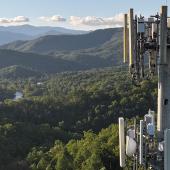This blog post is part of the "Tech Talk" series focused on the First Responder Network Authority’s (FirstNet Authority) standards development activities to support public safety. This post recaps discussions linked to public safety and other related topics from the 3GPP Plenary meetings that were conducted online June 29 – July 3, 2020. The FirstNet Authority represented public safety interests at the Plenary meetings.
Highlights
Following the online Plenary meetings held in March of this year, the June 3GPP Radio Access Network (RAN), Service and Systems Aspects (SA), and Core Network and Terminals (CT) Plenary meetings were also held electronically with the use of a combination of GoToMeeting sessions and email. 3GPP has now converted all face-to-face meetings to e-meetings through the end of 2020.
One of the most significant outcomes from the Plenary meetings is that 3GPP Release 16 (R16) is now officially frozen across the three TSGs (Technical Specification Groups). This is an important landmark as it includes the completion of Phase 2 features for 5G and important new Public Safety features including MCPTT (Mission Critical Push to Talk) and MCData (Mission Critical Data) interworking with LMR (Land Mobile Radio, i.e., legacy public safety systems). Important strides were also made in device positioning (see the RAN report below), service continuity for 5G network relay (see the SA report below), and enhancements to MCPTT and MCData (see the CT report below).
The following TSG reports provide details on each of these Plenary e-meetings with a focus on public safety activities. Representatives from nearly all major mobile equipment vendors, chip manufacturers, software vendors, and network operators from about 35 countries participated, as well as the FirstNet Authority and other government agencies representing public safety interests.
The Radio Access Network Plenary
The RAN Plenary meeting involved over 570 online participants.
The major topic of interest to public safety was the initiation of a study on 5G User Equipment (UE) positioning (i.e., location, both absolute and relative) using sidelink. A strong case was made for sidelink use cases covering V2X (vehicle to anything) and public safety to be supported by the UE. The goal is to enhance positioning accuracy in multiple scenarios including in-coverage, partial coverage, and out-of-coverage. The positioning accuracy target for public safety is less than 1m horizontal, less than 2m vertical (indoor for floor detection), and less than 0.4m vertical (relative) to detect changes in height of the UE. This study will facilitate future 3GPP work through completion of two main objectives: 1) identify the positioning use cases and requirements for V2X and public safety, and 2) identify potential deployment and operational scenarios.
Another topic of interest to public safety is the study of 5G sidelink-based UE-to-network and UE-to-UE relays. This study will address topics including Relay UE (re-)selection criteria, Relay/Remote UE authorization, and enhancement of sidelink discovery.
The Service and Systems Aspects Plenary
The SA TSG is responsible for the overall architecture and service capabilities of 3GPP based systems. The SA Plenary meeting included over 300 online participants. The primary focus was on progressing R17 architecture specifications and R18 requirements.
R18 Stage 1 requirements are in an early phase. There are many studies already approved for R18 with a few mission critical (MC) items in the mix including a study on off-network communication for railways, a study on sharing administrative configuration between interconnected MC Service systems, and a study on ranging-based services that will define requirements for off-network positioning and ranging.
Progress has been made on key features for public safety such as 5G Multicast-Broadcast services (5MBS) and 5G Proximity services (ProSe). A study on the architectural aspects for using satellite access in 5G has been completed, and normative work to develop a technical specification will now begin. Using satellite access in 5G is an important feature in extending wireless coverage for public safety.
As we reported in our 2020 March Plenary blog, a long and involved e-discussion took place about the inclusion of service continuity for the UE-to-Network relay in R17. During this SA Plenary, a revised study item was presented and approved to include this feature in R17 for public safety. As discussed previously, service continuity is an important feature since its goal is to keep communications going when a user's device loses radio contact with the network and creates a path to the network through a relay device.
SA approved a new work item on User Plane Integrity Protection (UPIP) for the 5G radio. As we previously reported, the FirstNet Authority has supported the inclusion of mandatory UPIP from R16 onwards. Integrity protection prevents data from being modified in an unauthorized or undetected manner. This work item will increase the security protections provided by the 3GPP system by extending the integrity protection capability of the 3GPP network's signaling plane to the user data plane. Note, however, that these security features are one level below the MC applications that have always provided support for both confidentiality and integrity protection of all MC signaling and data.
Work continues on architectural aspects of MC services such as MCPTT, as well as other verticals like railway and V2X (which builds economies of scale for public safety). Good progress has been made in spite of the current e-meeting challenges. The study into location enhancements for MC services was completed; significant progress was made on enhancements to MCData and MCPTT; and a new specification defining MC services support in the IOPS (Isolated Operation for Public Safety) mode of operation was advanced. Finally, a new study item was approved to investigate architecture issues and solutions for a MC Gateway UE function that would support multiple non-3GPP devices connected to 3GPP MC services via the Gateway UE.
The Core Network and Terminals Plenary
The CT work covers the protocol details and follows the requirements and architectural work performed in the SA working groups. The CT Plenary e-meeting included over 180 online participants.
The approval of R16 now provides public safety with the 3GPP standardized interface for LMR-LTE interworking supporting MCPTT group and private calls and MCData short data service. Work continues in the Alliance for Telecommunications Industry Solutions (ATIS) and Telecommunications Industry Association (TIA) to standardize the LMR side of the interworking interface.
At this meeting, the FirstNet Authority provided enhancements to the preconfigured regroup and functional alias features, and some improvements to the MCPTT user profile. Functional alias was also added to MCData. The functional alias feature provides the ability to display the role of a user as they talk or send data, such as "Incident Commander".
Phase 2 of 5G was completed except for some small aspects of network slicing and V2X, both of which will be completed in August. The Plenary meeting granted these exceptions to ensure completeness of the R16 work.
Public safety enhancements of MCPTT, MCData, MCVideo and LMR-LTE interworking were under discussion regarding R17 content. It is envisioned that functional alias would be added to MCVideo, and preconfigured regroup would be added to MCData and MCVideo, along with other small features and enhancements. Enhancements to LMR-LTE interworking might be considered in 2021. This would happen after the LMR portions of that work in the ATIS and TIA are finished to extend the already completed 3GPP LMR-MCPTT and LMR-MCData work to the LMR system side.
Further information on the 3GPP’s work and organization can be found at: www.3gpp.org.




















